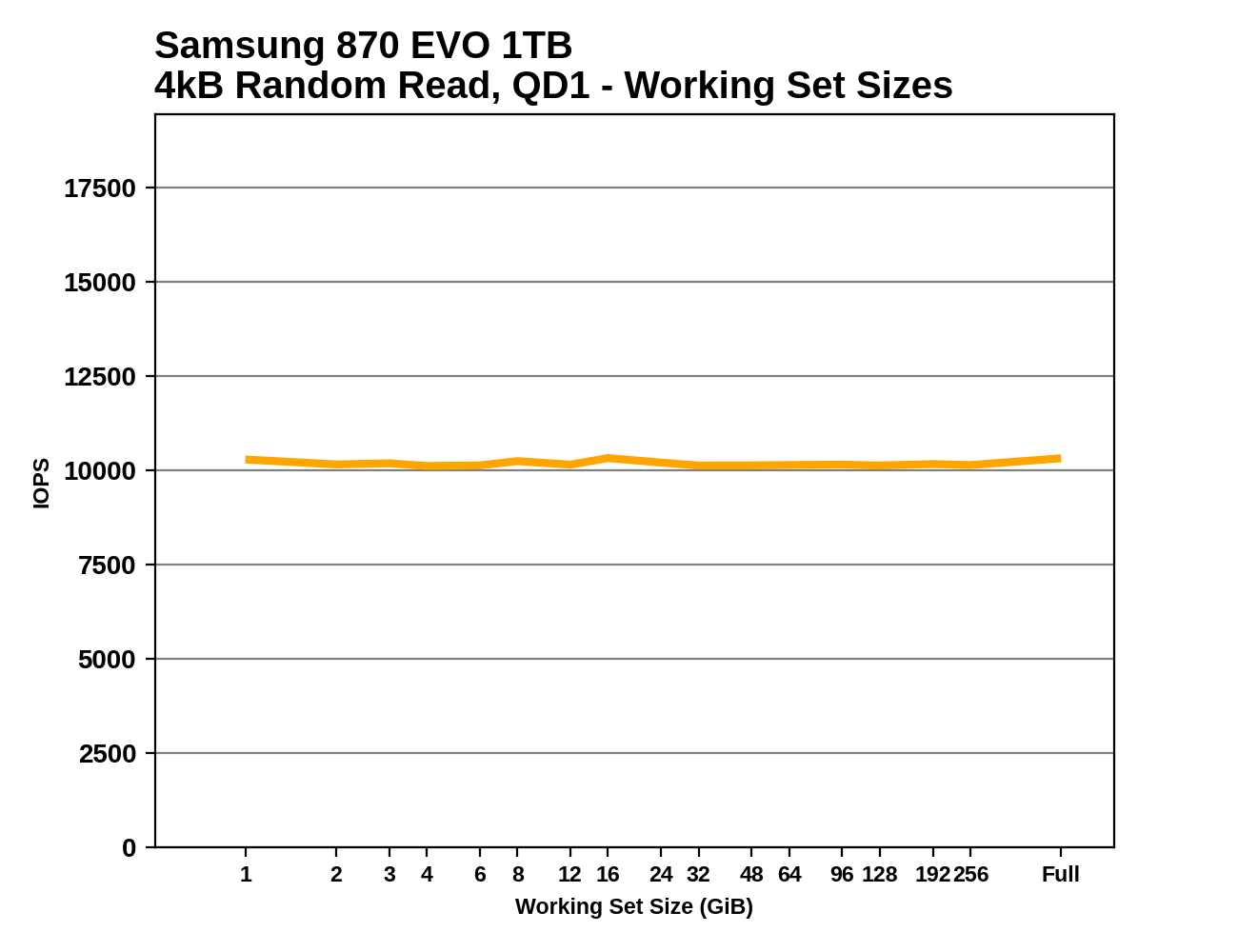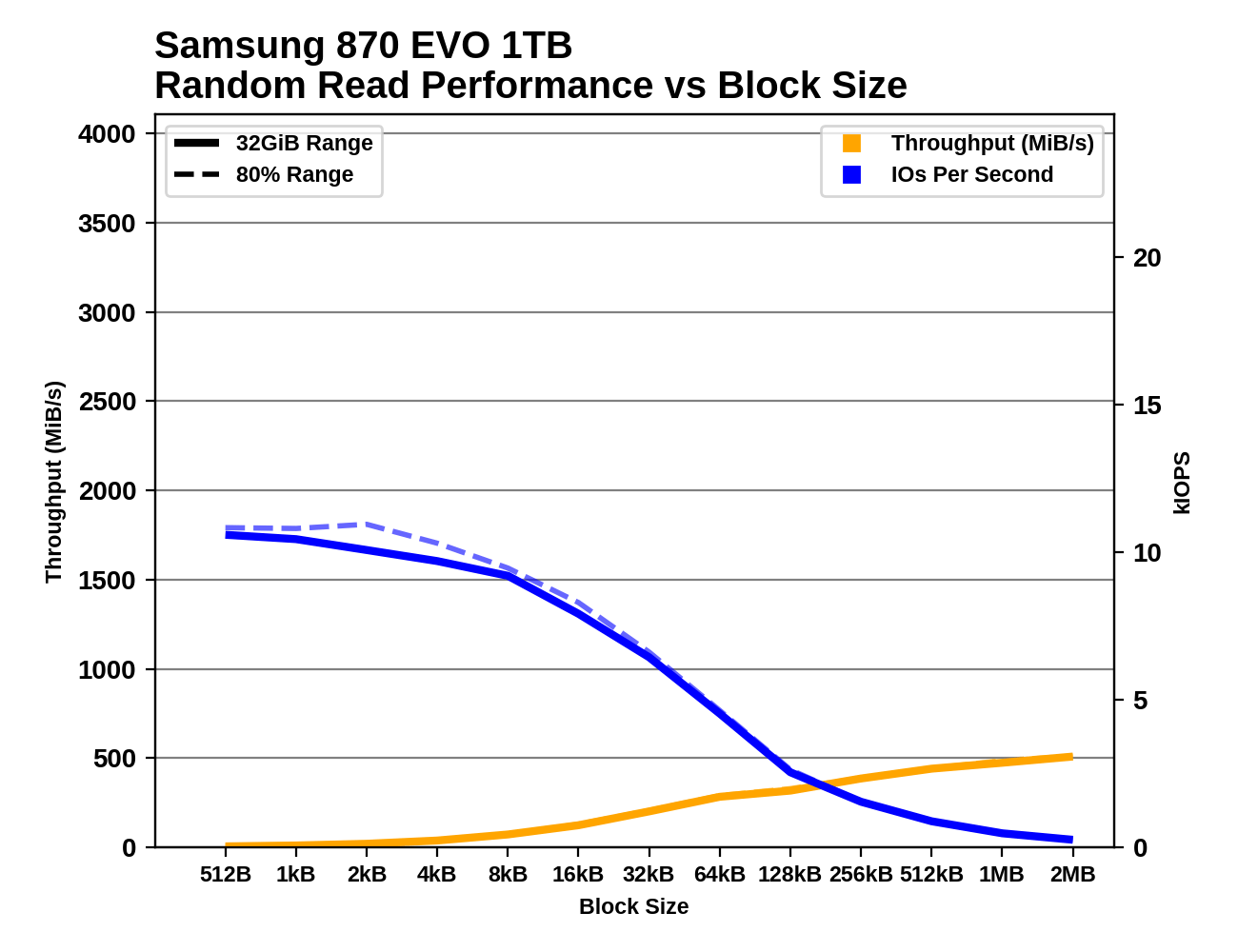The Samsung 870 EVO (1TB & 4TB) Review: Does the World Need Premium SATA SSDs?
by Billy Tallis on February 17, 2021 8:00 AM ESTAdvanced Synthetic Tests
Our benchmark suite includes a variety of tests that are less about replicating any real-world IO patterns, and more about exposing the inner workings of a drive with narrowly-focused tests. Many of these tests will show exaggerated differences between drives, and for the most part that should not be taken as a sign that one drive will be drastically faster for real-world usage. These tests are about satisfying curiosity, and are not good measures of overall drive performance. For more details, please see the overview of our 2021 Consumer SSD Benchmark Suite.
Whole-Drive Sequential Fill
 |
|||||||||
| Pass 1 | |||||||||
| Pass 2 | |||||||||
Some of our other tests have shown a few signs that the 870 EVO's write performance can drop when the SLC cache runs out, but this straightforward sequential write pass over the entire drive doesn't reveal any such behavior. The 870 EVO's sequential write performance is extremely consistent, even on the second write pass.
 |
|||||||||
| Average Throughput for last 16 GB | Overall Average Throughput | ||||||||
Due to the excellent performance consistency, the Samsung 870 EVOs edge out the other SATA drives with marginally higher average sequential write speeds. The entry-level NVMe drives end up much worse off than the mainstream SATA drives once their caches run out, but the more mainstream NVMe drive blows them all away.
Working Set Size
 |
|||||||||
As expected, the Samsung 870 EVO's random read performance shows basically no variation across a range of working set sizes, and that read performance is at least a little bit faster than any of the other SATA drives or the entry-level NVMe drives.
Performance vs Block Sizes
 |
|||||||||
| Random Read | |||||||||
| Random Write | |||||||||
| Sequential Read | |||||||||
| Sequential Write | |||||||||
There are no particular surprises in how the Samsung 870 EVO handles IOs of different block sizes. Unlike some drives, it has no trouble with sub-4kB IOs. It offers moderate improvements over the 860 EVO for mid-sized random reads (up to about 128kB). The one negative is that for writes we again see more inconsistency from the 870 EVO than the 860 EVO when testing an 80% full drive. The simple whole-drive sequential write test may not have been able to reveal any SLC caching troubles, but it does seem clear that the caching behavior has some performance regressions for more complicated workloads on a drive that's more well-used—though it's still unlikely to matter for any typical real-world consumer workload.










136 Comments
View All Comments
Krimzon - Wednesday, February 17, 2021 - link
Early USB standards were uni directional. 3 and 4 are full duplex.PixyMisa - Thursday, February 18, 2021 - link
10Gbps USB is already twice as fast as 6Gbps SATA because it uses more efficient encoding. 20Gbps USB is available right now, and 40Gbps is part of the USB 4 spec though I don't know how widespread support for it is.Wereweeb - Wednesday, February 17, 2021 - link
No need to replace SATA, it will die by itself. What we need is high-end consumer motherboards to get U.3.Billy Tallis - Wednesday, February 17, 2021 - link
U.3 is probably only going to be around for two or three product cycles. It's very much a stopgap solution to unify U.2 and SAS, both of which are already on the way out in favor of EDSFF.Wereweeb - Thursday, February 18, 2021 - link
Great! Then they can introduce it for consumers to have 2.5" drives again.Leeea - Wednesday, February 17, 2021 - link
The nice thing about SATA SSDs is they tend to just work. Pull one out of one system, stick them in another, and it can boot.The pci drives seem to be a lot more fussy with that.
danbob999 - Wednesday, February 17, 2021 - link
Not really. All drives (IDE / SATA / NVMe / USB / Whatever) pretty much just work. The problem is the OS may not boot. When switching to a different protocol (say SATA to NVMe), you increase chances it won't boot.Linux is easier to get to boot than Windows when changing the drive to a different system.
Jorgp2 - Wednesday, February 17, 2021 - link
Nah, it all comes down to EFI vs MBR.MBR systems just look for a boot partition and boot it, EFI actually stores the location on the motherboard flash.
WaltC - Wednesday, February 17, 2021 - link
Agreed...;) I might say "UEFI vs. Legacy," though. And much of it has to do with the knowledge, experience, and skill of the computer operator...! No question about that. (It's actually MBR vs. GPT--GPT is better. All of my SATA HDDs are formatted GPT, etc. I have no MBR-formatted drives.)The list of NVMe drives here is curious. Where is the 980 Pro from Samsung?--been selling for a while now--one of several PCIe4 NVMe drives available. Makes me question when this article was actually written....? It seems incomplete or out of date. Samsung is a chip company no longer in the business of making platter drives (last I looked, anyway-do they still sell the Spinpoints?), so it's natural for them to sell SSDs of varying types, sizes, and prices, imo.
Billy Tallis - Wednesday, February 17, 2021 - link
I deliberately chose not to include 980 PRO results in the graphs for this review, because that's a silly comparison to make against a SATA drive. But if you really care, you can use Bench: https://www.anandtech.com/bench/product/2724?vs=27...